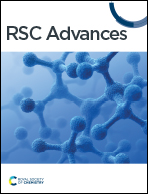Self-assembled molybdenum disulfide nanoflowers regulated by lithium sulfate for high performance supercapacitors†
Abstract
Recently, molybdenum disulfide (MoS2) has been extensively investigated as a promising pseudocapacitor electrode material. However, MoS2 usually exhibits inferior rate capability and cyclability, which restrain its practical application in energy storage. In this work, MoS2 nanoflowers regulated by Li2SO4 (L-MoS2) are successfully fabricated via intercalating solvated Li ions. Via appropriate intercalation of Li2SO4, MoS2 nanosheets could self-assemble to form L-MoS2 nanoflowers with an interlayer spacing of 0.65 nm. Due to the large specific surface area (23.7 m2 g−1) and high 1T phase content (77.5%), L-MoS2 as supercapacitor electrode delivers a maximum specific capacitance of 356.7 F g−1 at 1 A g−1 and maintains 49.8% of capacitance retention at 20 A g−1. Moreover, the assembled L-MoS2 symmetric supercapacitor (SSC) device displays an energy density of 6.5 W h kg−1 and 79.6% of capacitance retention after 3000 cycles.



 Please wait while we load your content...
Please wait while we load your content...